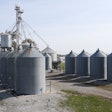On average, between crop years 2006/2007 and 2010/2011, 1 metric ton of distillers’ grains (DDGS) produced for animal feed by U.S. ethanol plants substituted for about 1.22 metric tons of corn and soybean meal combined, according to a report by the U.S. Department of Agriculture.
These findings may result in a net increase in DDGS in animal feed, as over time the amount in beef cattle feed declines but the share in dairy cattle, swine and poultry feed increases, according to the report. “As the market share for beef cattle declined, market shares for dairy cattle, swine and poultry increased,” said the report. ”Beef cattle’s DDGS substitution rate for corn is higher than any other type of livestock/poultry but is the lowest for soybean meal. Changes in aggregate substitution rates are expected to slow as annual market shares by type of livestock/poultry stabilize.”
Corn and soybean meal quantities fed in the U.S. have moderated or declined in recent years, due partly to the substitution of DDGS or other ethanol coproducts (corn gluten feed or corn gluten meal) for corn and/or soybean meal. As of the 2010/2011 crop year, DDGS replaced soybean meal as the number two feedstuff fed, and is second only to corn, according to the USDA.
While ethanol expansion raised the demand for corn, DDGS from the dry-mill production process partially offsets the impact on the feed market. Consequently, the net effect in the domestic feed market of a bushel of corn being used for ethanol production is less than a bushel. For example, the amount of feed (corn and soybean meal) replaced by the DDGS represents about 38% (weight basis) of the corn used in the associated ethanol production process for a given crop year.
According to the USDA, future industry surveys could provide additional information on DDGS substitution for corn and soybean meal, including information on the market share of DDGS consumed by type of livestock/poultry and the substitution rates of DDGS for corn and soybean meal by type of livestock/poultry.

















